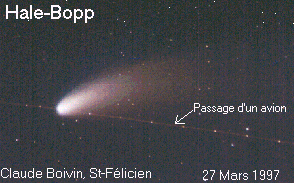 |
 | ||||||||||||
|
|||||||||||||

Comets
I got a question about comets, so I spent an hour on them. Of course 1997 was the year of Hale-Bopp, and some of the children remembered seeing that one. Almost no one remembered Hayakutake from 1996, which surprised me a bit. I brought in a cooler with dirty snow to show them how loose and light comets are. We talked about where they come from (the Oort cloud), and how big this cloud is relative to the biggest planetary orbit, and how the Oort cloud got formed, and about the fact that comets are representative of the stuff that the solar system was built from, and that NASA was going to fetch a piece of a comet soon. This is the time to stress the difference between comets and asteroids, which fall on the earth, and can be as dense as the crowbar I brought in, just to show the difference with (the bulk of) cometary material. (more text to come...) Here are some comet links: |
|||||||||||||

Sound
We spent an hour on the subject of sound. This time I violated my no-tech rule, because I brought in my old scope and a microphone. This was a great hit, as the microphone was passed around, and the kids made high notes, low notes, whistled etc and saw little waves, big waves and all that on the screen. I had also brought in some 78 rpm records, and magnifying glasses. The grooves on 78's are coarse enough so that you see the wiggles in the grooves. Then I played one of those records, using a pencil, a regular sheet of paper and a straightpin.
I did an hour on sound again the next year, with some different demos, and
some the same.
Take a look here.
|
|||||||||||||
|
Eclipses, and phases of the moon Good timing in both cases, because in '98 a total solar eclipse was going to occur on the October 26th, unfortunately only partial here in New Mexico (you'd have to go to Panama, Columbia, Venezuela, or some Carribean islands to see the total eclipse). In October 2004 a total lunar eclipse occurred that same week. Here is a great introduction to eclipse causes, effects and patterns. How to show eclipses in the classroom - especially when the room cannot be darkened very well? I got a 120W spotlight which I put into a droplight fitting, which I clamped onto my tripod. This made an adequately bright sun. I brought in a globe, and a little lego guy (with sticky feet) to stand on it, and a variety of little and medium balls I had around the house. The marble-sized beads are good to show the umbra and the penumbra, and I had some white styrofoam balls (erstwhile christmas tree decorations), which are great to show the phases of the moon with. A coathanger to stick the balls onto comes in handy when you need to make them fly around the globe. This is pretty much all you need to explain the phases of the moon, and incidentally also that the planets interior to the earth (Mercury and Venus) show phases just like the moon, and why the outer planets don't. You can show that while solar eclipses can be seen only if you are in the right place, lunar eclipses can be seen from any place on earth (well, only half). You can show how total, partial and annular eclipses work. While I had the stuff out, it was easy to show why we can't see the backside of the moon. After all this, you can see if they can figure out why solar eclipses only occur at the new moon, and lunar eclipses only at the time of the full moon. If they got this right, they really undestood the whole story. Here is a bunch of links with pretty pictures, and lots more: First some solar eclipse links:

Here are some lunar eclipse sites:
And finally an extraterrestrial eclipse site:
I did this one again on 5 Jan 99, and updated the '99 links. Updated October 2004. |
|||||||||||||
 February 98: Where do all the animals come from?
Time for a break from all the space stuff. There had been some
other vague questions about animals and plants, so here was an
opportunity to talk about evolution, one of the great pillars of science
that the kids should be familiar with.
February 98: Where do all the animals come from?
Time for a break from all the space stuff. There had been some
other vague questions about animals and plants, so here was an
opportunity to talk about evolution, one of the great pillars of science
that the kids should be familiar with. I decided to make up a game that could be played in class that would show evolutionary pressure, drift, divergence and all that good stuff. Here is how it went: First I set the scene: We have a small green valley, with brush, trees and grass, all drawn on the board, and we are going to play at being these medium-sized herbivores. They live for 4 years, then they die.
In the next phase, we're going to throw in some random variation. In addition to the age-cards, I had made up 14 simple tape measures
Then evolutionary pressure strikes: the climate in our little valley changes, and it turns into a a plain with a little grass and trees, but no more brush. There is not enough food for the medium-sized brush eaters, and they die off. The taller animals get to munch on the trees, and a few of the smallest animals get to survive on the grass. After a few rounds/years/generations it becomes clear that we now have two different types of animals where we started with one type. Just throwing the dice and some environmental pressure led to emergence of new species. That's just about all we got done in one hour. The next week, I reviewed the game, and put the proper names to various things we had done. While we were playing the game the week before, I had had no time to introduce the terminology ('evolution', 'survival of the fittest' etc.), or any of the names (Darwin, Wallace). By coincidence, I had just received the Feb 98 issue of Scientific American, in which there was an article about the emergence of antibiotic resistance - a prime example of evolution in real-time action in our world, and I used that to stress that evolution is not just a thing of the past. Also, that under current circumstances, that the human race can no longer evolve. Of course, while we were on the subject, I had to mention DNA,
stepping down in scale from my fingertip to cells, then nuclei and
finally DNA. I had made up some new covers for a set of paperback books
of various thicknesses, a fat one titled 'How to make a Person', an
equally thick volume 'How to make a Monkey', a thinner one 'How to make
a Frog, and a single sheet titled 'How to make Bacteria'. These codebooks
are supposed to be written with only the letters C,G,T and A. Another
important point about these codebooks is that they contain many almost
identical chapters and pages between them, even between the 'Person' code
and the 'Bacteria' code. (Feb 16 98)
Finally, a collection
of related links:
|
|||||||||||||
| |||||||||||||
